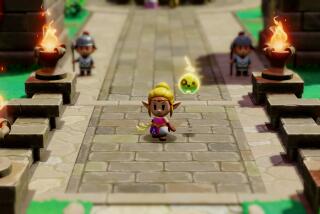How hit game maker Sam Barlow aims to remake choose-your-own-adventure stories
- Share via
Games have long used the word “cinematic” as a bragging point, encouraging players to take a starring role, so to speak, in their own interactive story.
Lately there’s been a shift, as evidenced by an episode of Netflix’s “Black Mirror” that went the choose-your-own-adventure route. Even the streaming service’s “Russian Doll” felt game-like in its narrative, with a lead character repeatedly dying only to have to play the game of life again and again.
Expect to see more experiments in non-passive viewing as more platforms, be they Apple, Twitch, YouTube or Facebook, take an interest in original content. Sam Barlow, however, isn’t so much focused in melding the worlds of gaming with scripted entertainment. He’s been trying to devise a new format altogether.
The developer of the 2015 hit game “Her Story,” a sort of murder mystery in which players investigate a crime by digging though vintage clips of a police interrogation, returns later this year with “Telling Lies,” a far more expansive and topical work that once again utilizes full-motion video. From the interactive division of Annapurna Pictures, “Telling Lies” essentially uses a search engine as game controller, turning players into voyeurs in an attempt to unravel the not-always-ethical secrets of four central characters.
Think of it as a film, but one that’s been spliced and diced. The puzzle then is double-sided: What is the story we’re trying to untwine, and who wants to figure it out?
“Conventionally, we would curate for you and and say, ‘Here is the story, and you’re going to feel these things and pick up on these things.’ That’s valid. But this is a different and interesting and fresh way of saying, ‘All that stuff is there, but it’s up to you to go find it,’” Barlow says.
“I think there’s a unique marriage with the interactivity, where just by telling someone to play a game, whether it’s ‘Candy Crush’ or whatever, the act of using your fingers to press a thing or type a thing is telling your brain that I am involved in this thing — this is happening.”
The nine or so hours of intimately shot footage — all the filmed scenes are framed to look as if people are talking via a smartphone or a webcam — span two years in the characters’ lives, and viewers jump in and out by acting as something akin to a researcher. Search, for instance, the word “love,” and every conversation in which the phrase appears will be available; the clips will start at the exact moment the word is said, asking those playing to rewind and fast-forward to construct the narrative jigsaw puzzle.
It’s a more active approach than what you get in a typical choose-your-own-adventure format. In the latter, viewers generally direct the action by picking between a pair of options, but then sit back and watch it all unfold. This method ultimately creates a sense of distance — the player is never truly in control of the narrative. Such was a criticism of “Black Mirror: Bandersnatch,” where some branches could result essentially in a dead end — a message, perhaps unintentional, from the writers that the player picked wrong.
“Fundamentally, why I am interested in doing interactive things is it’s the act of cheating the brain and boosting the suspension of disbelief and making you feel more integrated,” Barlow says. “All storytelling is about the imagination. When we tell stories, when we are really immersed in a movie or a show, a game or a book, you get to that beautiful point when your whole body is engaged in pretending this is real.”
Yet Barlow has often found himself frustrated when a television show or film adds game-like accouterments. In part, there’s never a form of consistent engagement — one is watching for a few minutes only to then be presented with a choice that pauses the narrative, forcing the brain to switch gears.
“It breaks that illusion,” Barlow says. “It doesn’t feel like it’s immersing you in the world. … You’re aware that you’re on a train track and you can’t help but try and figure what is the structure and how it fits together. Then you lost the audience. The story stopped being real.”
While “Her Story,” which over the years has been purchased about 1 million times if one counts sales with game bundles, didn’t fully remove the tracks of the plot, Barlow has been trying to find a way to ensure the player is actively a part of the mystery. Barlow is coy on the story of “Telling Lies” — uncovering it is essentially the game, after all — but it begins with the player in control of a stolen National Security Agency hard drive. It’s filled with hours of secretly recorded footage.
Here is where play begins, with participants trying to discover why the four characters had their privacy invaded, why the files were stolen and why someone wants to get to the bottom of it.
If all goes according to Barlow’s plan, “Telling Lies,” which has yet to receive a release date, will probe not just how technology has assaulted and dominated our lives, but how it’s also wreaking havoc on intimate relationships. The cameras roll after the conversation ends, allowing players to try to pick up on visual cues to determine the truth.
He cites 1974 thriller “The Conversation” and 2017 Nintendo title “The Legend of Zelda: Breath of the Wild” as equal sources of inspiration, wanting to tap the tension of the former with the wide-open feel of the latter. “Breath of the Wild” succeeded where other expansive video games failed, says Barlow, because instead of giving players a plot it essentially said, “just follow your own curiosity.”
“I think the beautiful thing here,” Barlow says of his goal for “Telling Lies,” “is by not having any idea that you are the protagonist of this story, you are motivated 100% by your interest in these stories and these characters. The gameplay is nothing but exploring the story and digging into characters.”
Barlow found inspiration in current events, both in issues surrounding government surveillance and the confusing world of dating apps and social media, where a wealth of information and photos can have two strangers revealing intimate details without pause — or even just carelessly posting revealing facts. Married and the father of a teenage son, the British designer admits to feeling skeptical, to say the least, of how “teenage courtship has been completely digitized.”
But one story played a larger role than others in the creation of “Telling Lies.” In 2014, one of Britain’s intelligence services, with help from the U.S. National Security Agency, was reported to have collected and stored millions of images from people’s Yahoo webcam chats. One detail stuck with Barlow: So much of the content was sexual in nature that agents tried to develop technology to block explicit images from the reviewing staff.
“This algorithm would detect an excessive amount of skin tone in the footage and then filter out these videos to protect the feelings of their agents,” Barlow says. “I remember reading this and being like, ‘What about the feelings of the people whose skin tone is being looked at by agents?’ Technology has changed relationships and how we relate to one another and how we’re intimate with one another.”
Add in the performative aspects of social media and Barlow had the themes for “Telling Lies,” a game he hopes will explore not just honesty between others, but how technology is inspiring us to be less honest with ourselves.
Let’s just say Barlow isn’t optimistic as to where this is all heading: “I want to get this out there,” he says, “before the world ends.”
Follow me on Twitter: @toddmartens
More to Read
The biggest entertainment stories
Get our big stories about Hollywood, film, television, music, arts, culture and more right in your inbox as soon as they publish.
You may occasionally receive promotional content from the Los Angeles Times.










